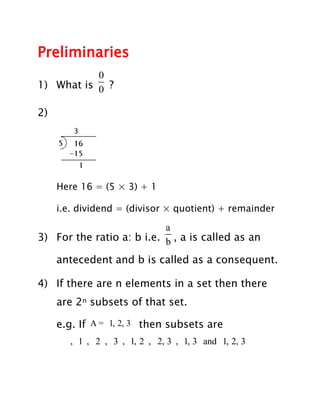
MHT-CET XI Maths - Preliminaries
- 1. Preliminaries 0 1) What is 0 ? 2) Here 16 = (5 × 3) + 1 i.e. dividend = (divisor × quotient) + remainder a 3) For the ratio a: b i.e. b , a is called as an antecedent and b is called as a consequent. 4) If there are n elements in a set then there are 2n subsets of that set. e.g. If A = 1, 2, 3 then subsets are , 1 , 2 , 3 , 1, 2 , 2, 3 , 1, 3 and 1, 2, 3
- 2. 5) Absolute value i.e. modulus value x means the absolute value or modulus value of x. It x is a positive real number then x x It x is a negative real number then x x If x is zero then x 0 In short x x for x 0 x for x 0 Note: -x does not necessarily mean negative. If x a then x=±a Graph of y x
- 3. x: -2 -1 0 1 2 y: 2 1 0 1 2 Graph is a right angle with vertex at origin. Poll Question 1 1 Which is greater 5 or 3 3 2 ?
- 4. Ans: LCM of 2 and 3 is 6 1 1 1 1 2 3 6 2 6 6 5 5 (5 ) 25 1 3 1 1 2 6 3 6 6 and 3 3 (3 ) 27 As 27 25 1 1 6 6 27 25 1 1 2 3 3 5 6) x co-ordinate is also known as abscissa y co-ordinate is also known as ordinate Where does the point (k, 0) lie ?
- 5. Poll Question a, b, c, d………x, y, z are distinct non-zero real numbers. Then the product (x-a).)(x-b).(x-c)………(x-z) is zero or non- zero ? 7) Zeroes of the polynomial. If P(x) is a polynomial such that P(α)=0 for any real number α, then α is called the zero or root of the polynomial P(x). Consider P(x)=x2+10x+16 Now P(x)=x2+10x+16=(x+2) (x+8) Clearly, P(x) = 0 if x = -2 or x = -8 ∴-2 and -8 are zeroes of the polynomial x2+10x+16.
- 6. 1 8) 2 0.5 is terminating decimal 1 3 0.333....... i.e. 0.3 or 0.3 is recurring decimal 9) For a triangle point of intersection of three i) Medians is called as centroid. ii) Altitudes is called as orthocentre. iii) Perpendicular bisectors is called as circumcentre. iv) Angle bisectors is called as incentre.
- 7. 10) Pythagoras theorem, Apollonius theorem, 30°-60°-90° triangle theorem, 45°-45°-90° triangle theorem. Poll Question 1) How many maximum number of common tangents can be drawn to two distinct circles 2 or 4 ?
- 8. Ans: 4
- 9. 11) Trigonometry Trigonon = Triangle Metry = Measures Poll Question What is unit of sin θ, degree or radian?
- 10. Ans: It’s a ratio. It has no unit. Express sin θ entirely in terms of tan θ Ans: sin tan cos 1 sin cos tan tan sec 1 1 tan tan 2 2 sec 1 tan
